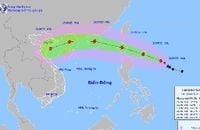As September draws to a close, Vietnam finds itself bracing for the approach of typhoon Ragasa, a formidable storm that has already drawn intense scrutiny from meteorologists and local authorities. According to the National Center for Hydro-Meteorological Forecasting, at 1:00 AM on September 21, 2025, the eye of typhoon Ragasa was situated at 17.7°N latitude and 127.8°E longitude, hovering approximately 600 kilometers east of Lu Dong Island in the Philippines. The storm packed maximum sustained winds at level 13—ranging from 134 to 149 kilometers per hour—with gusts reaching level 16, underscoring the potential severity of the threat.
The system was observed moving northwest at a steady pace of 10 to 15 kilometers per hour. Forecasters anticipated that, over the subsequent 24 to 72 hours, Ragasa would continue on this path, possibly gaining even more strength. By 1:00 AM on September 22, projections indicated the typhoon would be at 19.0°N latitude and 124.4°E longitude, about 240 kilometers east-northeast of Lu Dong Island, with wind speeds escalating to levels 14 and 15 and gusts exceeding level 17. The following day, at 1:00 AM on September 23, it was expected to maintain a northwestward track at 15 to 20 kilometers per hour, intensifying to level 16 winds and gusts above level 17, positioned at 20.3°N latitude and 120.3°E longitude over the northern waters off Lu Dong Island.
The dangerous area was clearly delineated: north of latitude 18.0°N and east of longitude 118.0°E, with the northern sea area of the East Sea (also known as the South China Sea) assigned a disaster risk level of 4. This means that, from the afternoon of September 22, the northeastern quadrant of the East Sea would experience winds at levels 6 and 7, quickly intensifying to levels 8 and 9 with gusts at level 11. Overnight, the winds would surge to levels 10 through 13, and near the typhoon’s center, winds could reach levels 14 through 16 with gusts surpassing level 17. Sea waves in these areas were forecast to rise between 4 and 8 meters, and in the storm’s core, waves could tower above 10 meters—creating truly perilous conditions for any vessels caught in the open.
Ships operating in this hazardous zone were warned they faced high risks from whirlwinds, violent winds, and massive waves. As a result, authorities in multiple Vietnamese provinces sprang into action, issuing urgent advisories and mobilizing resources to mitigate the storm’s impact. In Hai Phong, for instance, the city’s Civil Defense Command, following directives from the National Civil Defense Steering Committee, called upon local disaster prevention and search and rescue units to closely monitor Ragasa’s progress. They emphasized the importance of keeping ship captains and vessel owners informed about the typhoon’s position and trajectory, urging them to take necessary precautions to safeguard both lives and property.
Communication lines were to be maintained at all times, ensuring that any adverse developments could be addressed swiftly. The city also readied its rescue and relief teams, with equipment and personnel on standby for immediate deployment should the situation deteriorate. Local media—including Hai Phong’s newspapers, television, radio, and the Coastal Radio Station—were instructed to ramp up coverage, ensuring that updates on Ragasa’s evolution reached not only officials and vessel operators, but also the general public. The goal was clear: to enable everyone in the storm’s projected path to take timely, effective action.
In Ninh Binh province, similar measures were enacted. On September 21, the provincial People’s Committee issued Document No. 185/UBND-VP3, directing all departments, agencies, and localities to prepare for typhoon Ragasa’s potential arrival. Authorities were told to monitor weather warnings and forecasts with vigilance, ensuring that all ship captains and owners operating at sea received up-to-date information about the typhoon’s position, movement, and anticipated changes. The directive stressed the need for proactive avoidance of danger and the protection of people and property.
The Ministry of Military Command and the Provincial Police were tasked with preparing forces and resources for rescue and relief operations, should the need arise. Meanwhile, local radio, television, and mass media outlets were charged with intensifying their dissemination of information about the typhoon’s developments, ensuring that local governments, sea operators, and residents could respond in a timely and informed manner. Departments and agencies were assigned specific management and coordination responsibilities, working in tandem with localities to direct and facilitate disaster response efforts. A direct command center was organized to closely monitor the typhoon’s progress and report regularly to the Department of Agriculture and Environment via the Irrigation Sub-department.
Adding to the sense of urgency, reports from Kinhtedothi highlighted that typhoon No. 8 was simultaneously making a rapid approach toward mainland China, affecting the northern sea area. This meant that the East Sea was grappling with the dual threat of two powerful storms in close succession—an unusual and perilous scenario. Meteorologists warned that Ragasa, designated as typhoon No. 9 in Vietnam’s storm numbering system, could bring even greater intensity and broader impacts than its predecessor.
Recent experiences with severe weather have only heightened the sense of caution. As Kinhtedothi reported, previous storms this season have led to significant flooding and disruption in northern Vietnam. For example, after typhoon No. 5, heavy rains caused widespread flooding in Hanoi, with several urban areas like Ecohome and Resco facing deep inundation. Local officials had to convene emergency meetings to coordinate flood prevention and relief efforts, underscoring the importance of preparedness in the face of such natural disasters.
With Ragasa’s approach, the lessons from these earlier storms were not lost on authorities. Across the affected provinces, officials reiterated the need for vigilance, coordination, and rapid response. “We have instructed all relevant departments and localities to closely monitor forecasts and developments, and to ensure that all vessels at sea are informed and take necessary precautions,” a Ninh Binh official stated, as reported by Kinhtedothi. “Our rescue and relief forces are on standby, and we are working to ensure that all communication channels remain open and effective.”
For many coastal communities, the days ahead will be marked by a tense wait as Ragasa draws nearer. Fishermen and ship owners have been urged to heed official warnings, while families living in vulnerable areas are making preparations to secure their homes and belongings. The memory of past storms—and the devastation they can bring—looms large, fueling a collective determination to weather whatever Ragasa may deliver.
As Vietnam’s northern provinces brace for impact, the coming hours will test the readiness and resilience of both authorities and residents. With communication lines open, rescue teams at the ready, and a watchful eye on the horizon, the nation prepares to face the challenge head-on, hoping that careful planning and swift action will spare lives and minimize losses.





